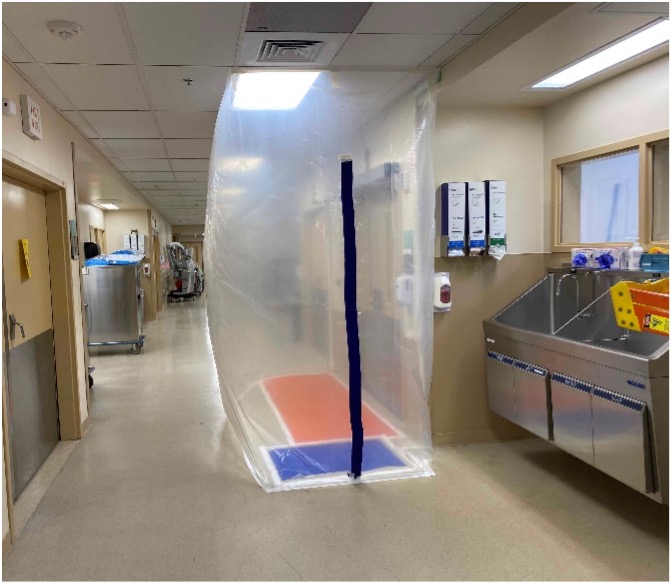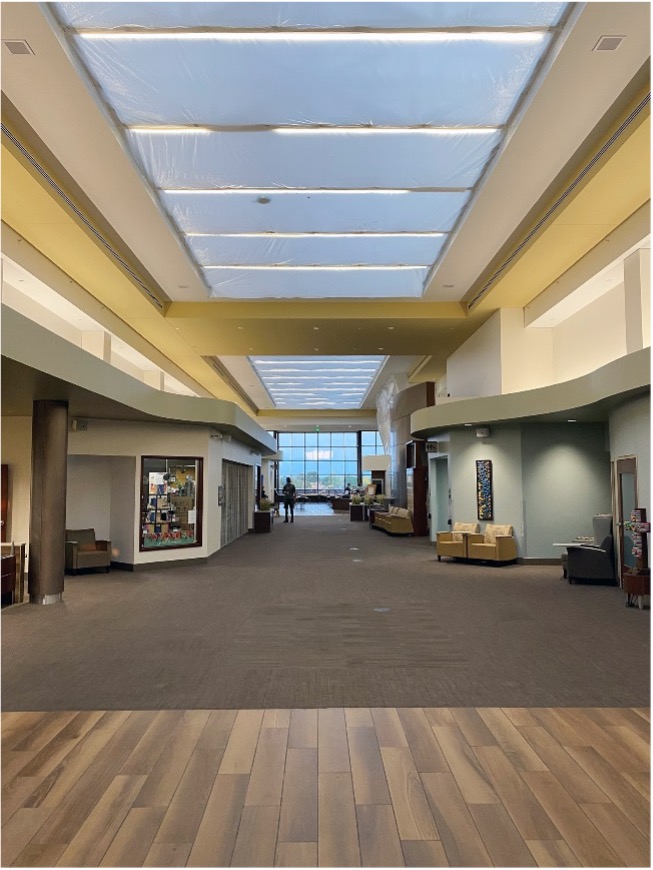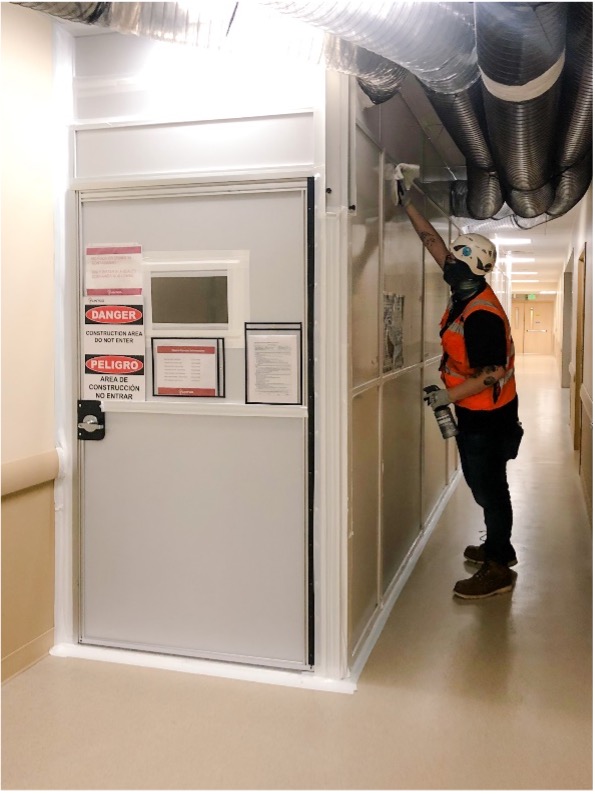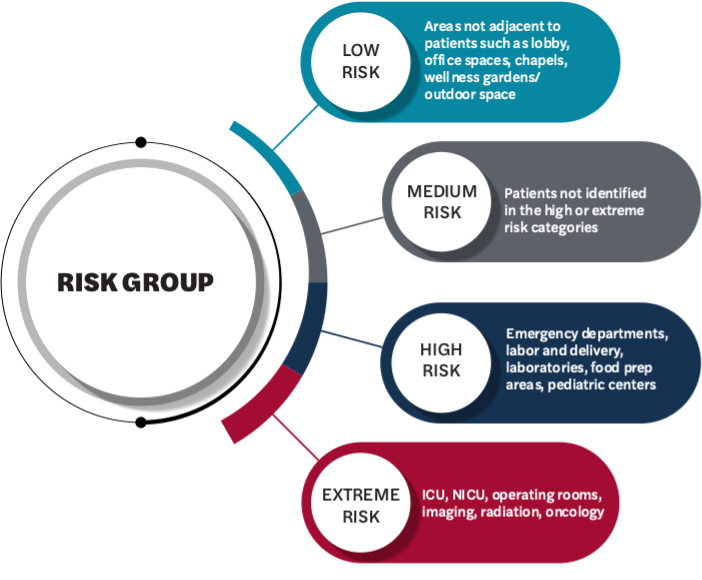Healthcare construction, particularly additions and renovations in an active healthcare environment, is prevalent as the industry is driven by growth, regulations, patient experience, physician staff preferences, and pandemic response. Keeping the health and safety of the staff, patients, and visitors is at the core of all construction. Communication and collaboration with nurses, facilities staff, and infection preventionists is imperative to ensure that construction activities will provide the best outcome for patients. With all these measures in place, a critical question remains: How do we effectively protect an area to prevent the spread of contaminants or even re-route construction activities and workers to minimize touchpoints with patients and staff?

Figure 1: St. Anthony Hospital OR Integration
Infection prevention and day-to-day hospital activities requires expertise and care that construction industry leaders, including Flintco, work to improve every day. Patient infection risks associated with construction in an active hospital include dust and airborne particles, an unbalanced ventilation system which compromises air quality, water penetration and stagnation, managing waste and debris. According to the Centers for Disease Control and Prevention (CDC), approximately 5,000 people die every year from Hospital-Acquired Infections (HAIs) linked to construction and renovation activities. Some of these HAIs include:
- Construction workers, materials, and bacteria can be brought into the hospital and spores can travel easily if not properly contained
- Activities involving vibration can release dust and mold spores into the air as well as cause patient stress and affects instrument performance
- Demolition activities can disturb and mobilize harmful bacteria and mold throughout the hospital

Figure 2: Littleton Adventist Hospital
Before every shift begins work, Flintco creates a plan for Infection Control Risk Assessment (ICRA) and how to mitigate each risk identified. This results in the Infection Prevention Plan (IPP). The type of activity performed will necessitate a different mitigation plan as well as identifying the risk group.
- Low Risk: Areas not adjacent to patients such as lobby, office spaces, chapels, wellness gardens/outdoor space
- Medium Risk: Patients not identified in the high or extreme risk categories
- High Risk: Emergency departments, labor and delivery, laboratories, food prep areas, pediatric centers
- Extreme Risk: ICU, NICU, operating rooms, imaging, radiation, oncology
During construction, Flintco employs infection prevention methods to prevent contamination such as:
- Ante rooms for negative pressure to prevent dust from spreading to adjacent areas
- Negative air pressure in areas where work is performed to contain odors and dirt from impacting immune-compromised patients
- Micro-organism contamination control mats to prevent the organism spread to clean floors
- HEPA-filtered vacuums
- HEPA air filtration systems
- The use of head/shoe covers and owning
- Self-containment / transition chambers
- Proper tools and slightly misting materials before cutting to minimize dust
- Multiple daily inspections of the work area to ensure enclosures are airtight and clean
Flintco goes above and beyond all ICRA protocols by adding another degree of certainty – making it personal. Infection prevention is everyone’s job to build a better world.
Understanding the impacts on health and safety that infection prevention has in a hospital environment takes training and a true passion to get it right. Flintco trains our construction teams to understand from a clinical aspect how our actions and behaviors can be the difference between life and death, healthy patients, and sick patients. Our planning and execution with protecting patients, staff, and visitors goes beyond just keeping negative air pressure or keeping dust contained. Flintco’s methods and protocols also address total environment of care including noise, life safety, circulation, and perception.
Vice President/Area Manager for Flintco’s Denver office, J.W. Stamison serves on the Quality and Safety Committee for two local hospitals. “This unique perspective allows us to see the importance of safety from healthcare executive and a caregiver’s viewpoint”, says J.W. “We focus on continuous improvement and key quality indicators for c. difficile infections, sepsis and overall patient satisfaction on those committees. It allows us to understand our clients and enhance our own programs that manage leading measures to ensure we are part of the solution in these important and ever-changing facilities.”
Further engaging the discussion in our role as a contractor, Flintco Construction Director Dave Kenney tells his teams to imagine being in a hospital on your worst day with a critically ill family member.
“Now imagine looking around and seeing a dirty, noisy, or congested area that is taken over by construction,” he says. “How would you feel on that day? Or how would you feel if you were a nurse or physician trying to care for someone near a construction containment?”
To make it hit home, he adds, “How would you feel if your newborn baby was in the NICU while unexpected noise and vibrations were occurring next door that caused undo stress to your baby that is fighting to survive?” Conversations like these, bring a deeper understanding of infection prevention and everyone recognizes how every action has a reaction – it makes it personal.

Figure 3: Parker Adventist Hospital West Wing Temporary Covid Separation Wall
This level of attention is brought to the jobsite from Day One as the project plan starts to take shape, as those are the situations to avoid at all costs to ensure that the environment of care is preserved throughout all construction activities.
An Infection Control Manager of a confidential healthcare client stated, “Flintco strives to provide the highest caliber of safe construction practices and rigorous infection prevention strategies to safeguard both patients and staff, while delivering the highest quality workmanship.”
Flintco insists to only bring trained professional healthcare constructors into a health and wellness environment and require each team member to undergo extensive infection risk assessment, prevention measures and safety training before performing exploratory investigation or work in any facility. This includes craft personnel and trade partners alike.
Flintco’s goal is to always be an extension of the facility and safety teams on any given campus. “If you see something, say something, and correct the situation,” says Flintco Project Manager Adam Kaufman. “The moment you park, your actions can either do harm or good.” For example, Adam observed a food delivery driver using a cart enter the hospital through the vestibule when he noticed the floors were dirty. He immediately acted and cleaned the vestibule so that dirt and debris would not enter the hospital. Flintco Superintendent, Wayne Saiz describes that events do not have to be construction related to help our healthcare partners as issues arise.
“The St. Anthony Hospital Facilities team once contacted our foreman at midnight to inform us that an obstruction was impeding the ambulatory entrance inboard of the hospital,” Saiz stated. “Our team immediately arrived at the hospital and met with the Emergency Department charge nurse.” Prioritizing our client partner, Flintco engaged the hospital’s need and rectified the problem, allowing the critical entrance, proper and safe access.

Figure 4: Edge Guard panels are wiped down inside and outside, taped joints are inspected for gaps, tacky mats are routinely refreshed, and the work area is always kept clean and dust free.
Minimizing disruption by communicating, collaborating, and pre-planning are what sets Flintco apart.
“We know that when we get into a space, we need to get out without the need to come back,” says Kenney. “Consistently getting it right the first time, allows the hospitals we work in to have the comfort in knowing that we will only turn over spaces in better condition than we found them.”
Flintco’s focus is to minimize disruption and build with a patient mindset. This deep appreciation for people is what makes every project personal.
